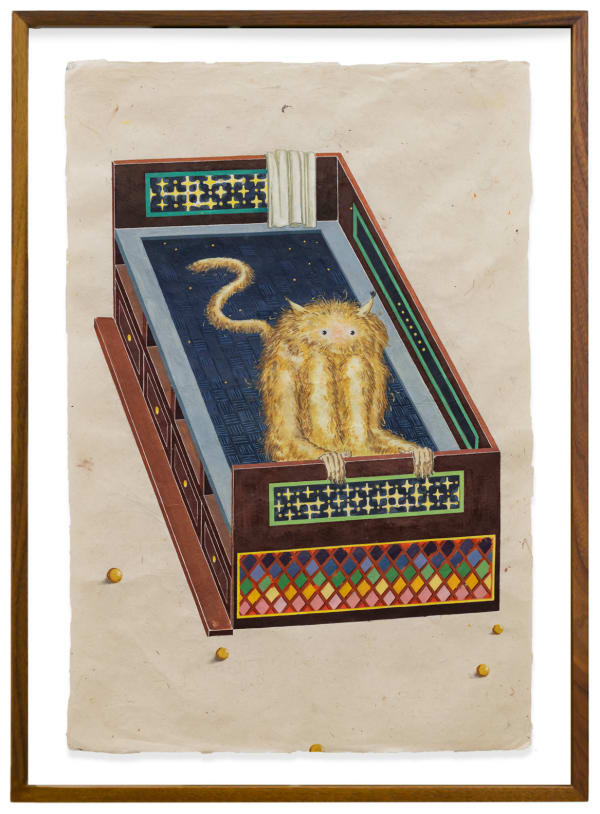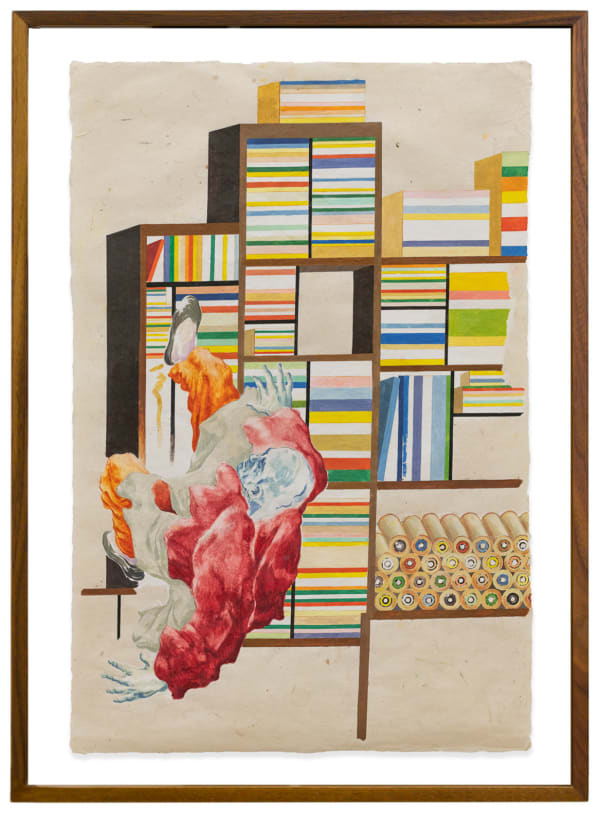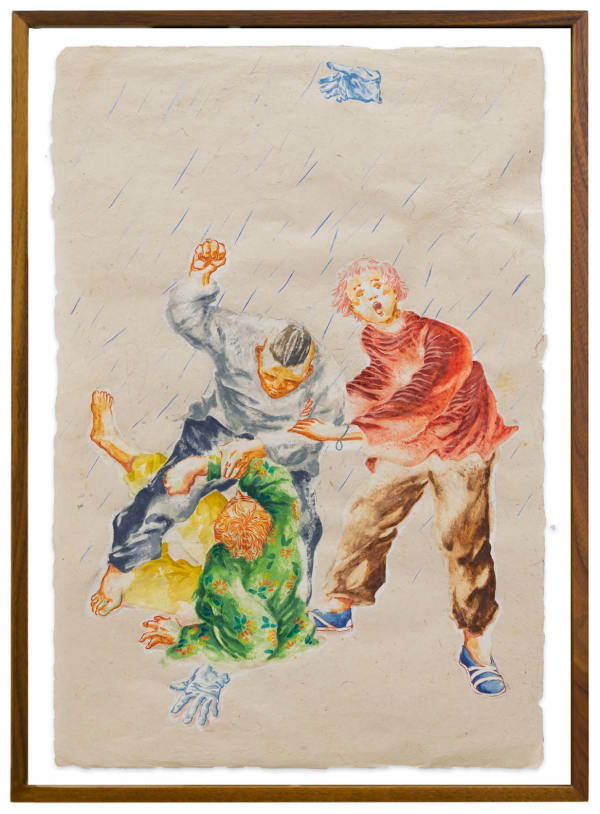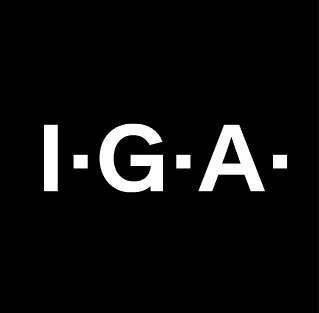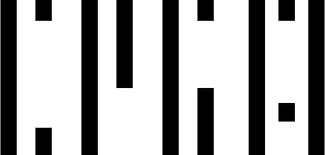-
Galerie Peter Kilchmann Paris / Zurich is thrilled to present the second solo exhibition with new works by Swiss painter Valentin Rilliet (b.1996, Geneva, Switzerland, lives and works in Geneva). The artist was previously featured in the group show Three New Positions, featuring emerging artists in 2023, and his first solo exhibition 蜀風 - Mountain Stories, in the following year, 2024. The Dream Synopsis is the artist’s first exhibition in Paris. The exhibition’s title refers to Rilliet’s approach to creating his recent works through a more open, associative, or dreamlike perspective, moving away from the site- and source-specific themes that characterized his previous series. In these new oil paintings and works on paper, the artist opens the narrative field of his practice, playfully creating a unique mythology through which he continues to develop his visual language.
-
-
While conceptualizing this new body of work, Rilliet participated in the Swatch Art Peace Artist Residency in Shanghai, China, for three months. He completed the paintings after returning to Geneva in the spring. This was his second residency in China within one year, after having previously spent six months in Chongqing, Sichuan Province.Raised in Geneva by a Chinese mother and a Swiss father, Rilliet’s work is deeply informed by a bicultural identity, which he neither simplifies nor resolves but rather uses as a creative and driving tension in his practice. Educated as a painter in Zurich and London, his visual style reflects influences from Russian-born American artist Sanya Kantarovsky, whose ironic figurations and psychological intensity resonate in Rilliet’s compositions. Additionally, R.B. Kitaj’s narrative approach, color-composition, and fragmented visual storytelling provide a deeper historical anchor for Rilliet’s explorations.
-

-
There are ten paintings on canvas and nine works on paper presented in the exhibition. Each piece contains a magic realist vision, uniquely composed and skillfully balanced. Central to each painting is a figure, usually in motion, that animates a distinct scenario. These figures often serve as protagonists within mysterious or ambiguous scenes that obscure the line between memory and imagination.Rilliet draws from elements of previous works series, expanding on his earlier use of Chinese socialist propaganda pamphlets and the so-called ‘picture books’ (连环画, Lián Huán Huà) as source material. He re-contextualizes fragments from these influences and combines them with landscapes, architectural motifs, and figures observed during his travels in China and creates layered compositions rich in metaphor and textures.Two of the central works in the exhibition, Sightline (overlooked) and Lagoon, signal a marked departure from Rilliet’s previously more theatrical, frontally composed tableaux. Painted from a bird’s-eye view, both works demonstrate the artist’s new interest in non-traditional perspectives and compositional dynamism.
-
A particularly experimental aspect of his new series was his application of Tibetan paper, ordered from Lhasa. The paper, thick and durable like scrolls for sacred texts and archival literature, is traditionally made from Daphne bush bark that makes it poisonous to insects, preserving it from decay. Rilliet explored this material’s limits, often struggling with its unpredictability. His first attempts saw ink bleeding too quickly or spilling across the surface uncontrollably. Equally challenging was to find out the correct application of oil paint. Yet he welcomed these challenges. He came to appreciate how the material itself began to dictate aspects of the narrative. The unpredictability became part of the process and was an eye-opening experience for the young painter who had previously approached his compositions with greater control while working on widely used materials.This relinquishing of control and the material-induced improvisation aligns with the free-associated logic underpinning the entire series. It’s a method that invites surprise, allowing the physical properties of the medium to influence the narrative as much as the artist’s own intentions.
-
In Sightline (overlooked), a pigeon occupies the immediate foreground, seemingly observing a charged social scenario unfolding below. A solitary figure lies in the doorway of a mansion, while across the yard, a group of men stands, facing them. The yard contains textured drag trails rendered with sand quartz, suggesting a physical or symbolic disturbance. Rilliet’s use of this material introduces an added layer of tactility and ambiguity. The scene’s narrative potential is suspended. It is unclear whether we see a confrontation or mourning. Thus, the artist allows multiple interpretative pathways to remain open.Lagoon, by contrast, stages a seemingly more benign act: a fisherman casting his net. Yet the bird’s-eye composition and the ripple-like structures of the water complicate the action, distancing the viewer from any definitive emotional register. As with many of Rilliet’s works, there is less of a fixed storyline than a constellation of gestures, symbols, and emotional cues. The artist uses the same perspective in the work Untitled (Reaper), which is in ink on Tibetan paper.
-
Additionally, the exhibition is also notable for its experimentation with format. Works like The Puppeteer, Motherhood, and Crystal Clear (Dusk) with their tall vertical or horizontal framing, and Sister Lychee, in a narrow horizontal canvas, reflect Rilliet’s exploration of spatial construction as an expressive device. In Sister Lychee, a girl mischievously peeks over a wall, while across from her looms a red demonic hand — a stark juxtaposition that collapses innocence and threat into a single, compressed frame. This interplay of humor, unease, and visual wit echoes the comic book idioms that Rilliet often references, while also resonating with an almost gothic tension. The Puppeteer portrays a figure holding a puppet aloft yet the strings are invisible, rendering the object eerily autonomous, suspended in an uncanny mid-air state. The absence of visible control devices imbues the painting with a magic realist quality, suggesting metaphors of manipulation and individual autonomy. Motherhood depicts a furry, dragon-like creature with a slightly rounded belly. Crystal Clear (Dusk) refers back to an earlier painting titled Dawn. In both of them, a human figure’s state is re-appropriated from a previously precarious circumstance into a new magical but still dark reality.
-
 Valentin Rilliet, Momentum, 2025, oil on canvas
Valentin Rilliet, Momentum, 2025, oil on canvas -
-
Material experimentation plays a key role in the new works on Tibetan paper. In some of them, Rilliet incorporates gansai, a traditional Japanese watercolor noted for its vivid pigmentation and opacity, as well as gold ink. Both of which are applied to Tibetan paper. The resulting surfaces are rich and luminous, but difficult to control, lending the works a sense of immediacy and material tension. These demanding media choices underscore Rilliet’s commitment to process and his willingness to relinquish full authorial control.Gold-Bearer features a monkey-like creature perched on a Chinese daybed with drawers, surrounded by five scattered orbs. It is inspired by a Chinese book about ancient mythologies that included humorous and fantastical tales. Works such as Archivist, Anointment, Escapade, Unshaken (there is no time for this), and Rules of Secrecy derive directly from Rilliet’s ongoing engagement with the aforementioned picture books and political pamphlets. In Strange Season, the viewer encounters a landscape populated by two small figures and where the viewer’s eye travels through layered planes rather than being fixed on a single point of entry. A visual approach inspired by what Rilliet saw in ancient Chinese scrolls. His selective appropriation of these motifs anchors his work within a matrix of cultural memory, subversion, and personal observations.
-

Galerie Peter Kilchmann
11-13 rue des Arquebusiers, Paris
, 24 May - 19 July 2025Be the first to know updates about Galerie Peter Kilchmann
* denotes required fields
We will process the personal data you have supplied to communicate with you in accordance with our Privacy Policy. You can unsubscribe or change your preferences at any time by clicking the link in our emails.




















